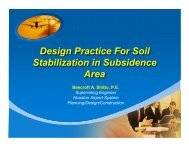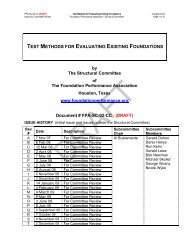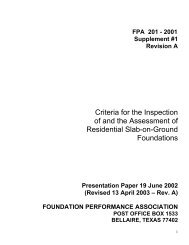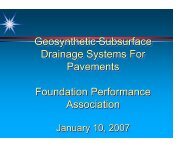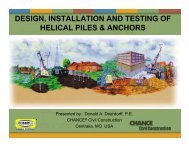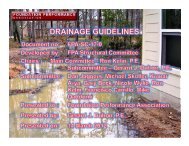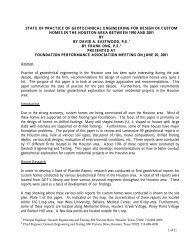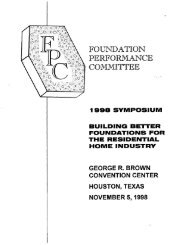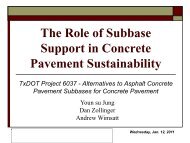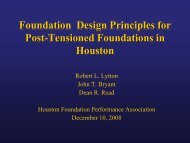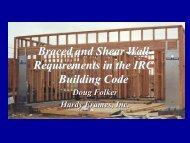Soil-Structure Interaction Seminar - Foundation Performance ...
Soil-Structure Interaction Seminar - Foundation Performance ...
Soil-Structure Interaction Seminar - Foundation Performance ...
You also want an ePaper? Increase the reach of your titles
YUMPU automatically turns print PDFs into web optimized ePapers that Google loves.
Geotechnical <strong>Foundation</strong> Design Criteria<br />
<strong>Foundation</strong>s for a residential structure should satisfy two independent design criteria. First, the<br />
maximum design pressure exerted at the foundation base should not exceed the allowable net<br />
bearing pressure based on an adequate factor of safety with respect to soil shear strength.<br />
Secondly, the magnitude of total and differential settlements (and shrink and swell) under<br />
sustained loads must be such that the structure is not damaged or its intended use impaired.<br />
It should be noted that properly designed and constructed foundation may still experience distress<br />
• from improperly prepared bearing soils and/or expansive soils which will undergo volume<br />
change when correct drainage is not established or an incorrectly controlled water source<br />
becomes available.<br />
The design of foundations should be performed by an experienced structural engineer·using a<br />
soils report 'from an experienced soils engineer. The structural engineer must use a lot/site<br />
specific soils report for the foundation design. The structural engineer should not use general<br />
subdivision soils reports written for underground utilities and paving for the slab des:gn.<br />
Furthermore, he should not design slabs with disclaimers, requiring future soils reports to verify<br />
his design. The designers or architects should not provide clients with foundation design<br />
drawings with generic foundations details. All of the foundation drawings should be site and<br />
structure specific and sealed by a professional engineer.<br />
Recommended Scope of Geotechnical studies<br />
<strong>Soil</strong> testing must be performed on residential lots before a foundation design can be developed.<br />
The recommended number of borings should be determined by a geotechnical engineer. The<br />
number of borings and the depths are a function of the size of the structure, foundation loading,<br />
site features, and soil conditions. As a general rule, a minimum of one boring for every four<br />
lots should be performed for subdivision lots. This boring program assumes that a<br />
conventionally-reinforced slab or a post-tensioned slab type foundation is going to be used.<br />
Furthermore, many lots will be tested at the same time so that a general soils stratigraphy can<br />
be developed for the entire subdivision. In the event that a drilled footing foundation is to be<br />
used, a minimum of one boring per lot is recommended. In the case of variable subsoil<br />
conditions, one to two borings per lot should be performed. A minimum of two borings is<br />
recommended for custom homes or a single in-fill lot. A minimum boring depth of 15-feet is<br />
recommended.<br />
GEOTECH ENGINEERING AND TESTING, INC. -------------·<br />
10



